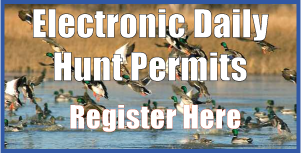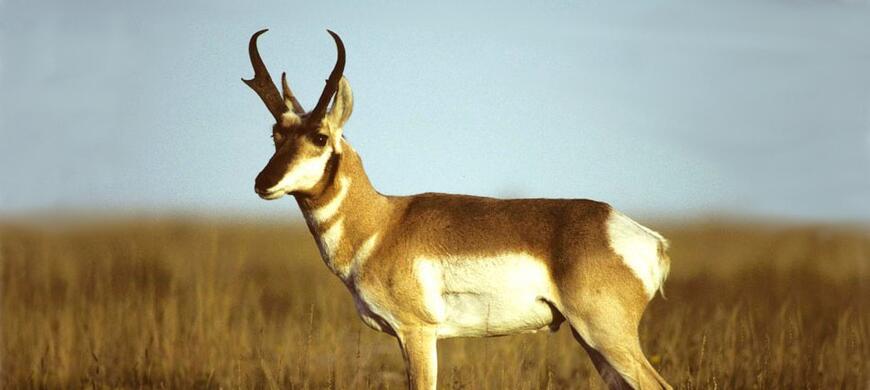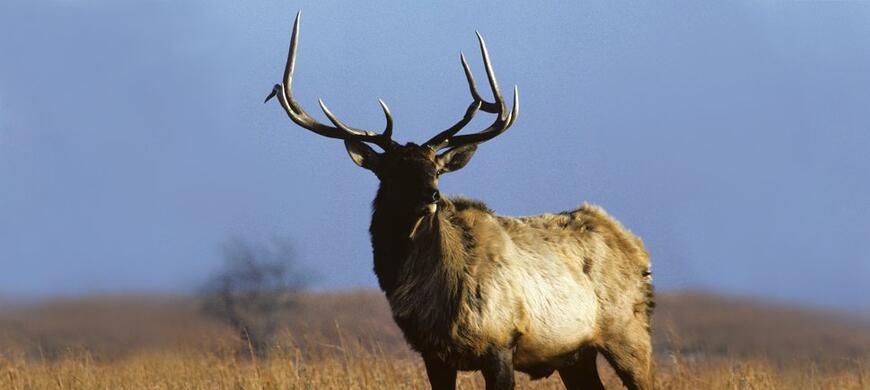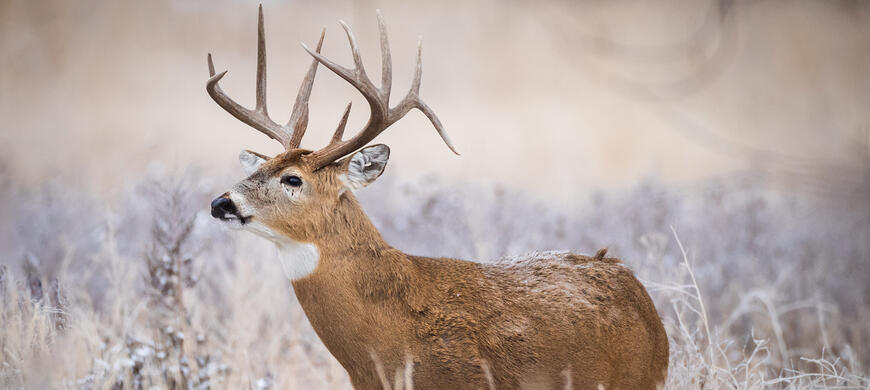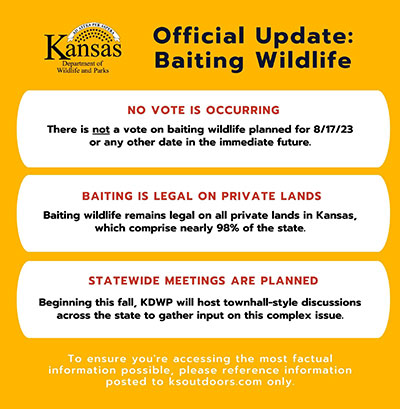Big Game Information
Big game hunting in Kansas is a relatively new heritage because nearly all big game species were extirpated from the state by 1900. Prior to settlement, the prairies of Kansas were home to tremendous herds of bison, elk, mule deer, and pronghorn antelope. In the timbered areas of eastern Kansas, white-tailed deer were abundant. The first modern deer season was held in 1965, and permits were limited. Today, white-tailed deer thrive statewide and permits for residents are sold across the counter. Mule deer are still common in western Kansas, though permits to hunt them are limited. Pronghorn antelope are limited to far-western counties where large areas of native prairie are still found, and residents can hunt them if they receive a coveted permit in the annual drawing. Similarly, elk are hunted through very limited permits. The only free-ranging elk herd in Kansas is found on the Fort Riley Military Reservation in Riley County. Hunters can receive a Kansas Trophy Certificate if the antlers or horns from a deer or antelope they kill achieves a minimum score. The department also maintains an unofficial Top 20 list for deer and antelope.
- Take a picture of the animal with your phone's camera making sure all the animal is visible.
- Open the Go Outdoors KS App and on the home screen, select "Harvest Reporting".
- On the "Harvest Reporting" screen you will see all your available tags.
- If you have multiple accounts on your phone, you can change to another account's available tags by selecting the name at the top of the screen. This will give you a list of everyone you have on your phone.
- Choose the tag you want to fill.
- Fill out the corresponding questions for the tag (harvest date, time, species, age, weapon used, unit and county).
- Click "Select Image" to select the picture you have taken of the animal.
- The last question, "Are you completing this Harvest Report for a Paper Carcass Tag?" If you are E-tagging select "No".
- Click "Submit" at the bottom and review all your answers for validation. Once reviewed click, "Submit" again.
- You should receive a popup success window with your E-tag confirmation number.
- If taking the animal to a processor or taxidermist, please write the confirmation down and attach it to the animal so it can stay with the animal.
To download the Go Outdoors KS mobile app to your Android device, visit: https://play.google.com/store/apps/details?id=com.brandtinfo.gooutdoorsks&hl=en_US&gl=US
To download the Go Outdoors KS mobile app to your Apple/iOS device, visit: https://apps.apple.com/us/app/gooutdoorsks/id1613997956
OFFICIAL UPDATE from the Kansas Department of Wildlife and Parks on Baiting Wildlife
We are aware that information has begun circulating online regarding baiting wildlife in Kansas. Unfortunately, most of this information has either been unintentionally misreported and/or shared out of context, rendering much of the information shared as unreliable and inaccurate.
To ensure our constituents, landowners, and industry members have access to the most factual information possible, we’ve created the following graphic for social sharing. Please help us in spreading this message, so that we may all make progress on this very important issue together as partners in conservation. Thank you!
KDWP is offering FREE, Limited Chronic Wasting Disease testing during the 2023-2024 deer seasons. For details, click "2023-2024 CWD Sampling Information" below or see CWD page in the 2023-2024 Kansas Hunting & Furharvesting Regulations Summary, here https://ksoutdoors.com/Hunting/Hunting-Regulations.
The first case of CWD was found in a captive bull elk in Harper County in 2001. As of 30 June 2023, CWD has been detected in 974 cervids, including 2 captive elk, 1 captive mule deer, and 971 wild, free-ranging deer. All Surveillance Zones in Kansas now have CWD detections. CWD surveillance began in 1996 and, to date, 35,534 cervids have been sampled and tested for CWD. Hunters and other wildlife enthusiasts can avoid the human-assisted spread of CWD by not transporting a live or dead deer or elk from areas where CWD occurs. HUNTERS ARE ENCOURAGED TO USE ELECTRONIC DEER CHECK-IN (E-TAG) OR LEAVE EVIDENCE OF SEX ATTACHED TO THE CARCASS. THEN, BONE-OUT DEER, AND LEAVE CARCASSES IN THE COUNTIES WHERE DEER ARE TAKEN. MOVING CARCASSES MOVES PRIONS AND CWD TO NEW LOCATIONS! There is currently no known treatment or eradication method for CWD, so preventing the introduction of the the disease into new areas is of utmost importance to the health of local deer herds. Baiting and feeding deer tend to concentrate deer at small point on the landscape, often with the trails leading to the feeding sites resembling the wheel spokes of a bicycle. Anytime animals are concentrated at this type of "hub," the likelihood of disease transmission increases in a deer herd. More alarming, the transferring of CWD prions to healthy deer is not the only concern. Diseases such as bovine tuberculosis, foot rot bacteria, fungal pathogens, and a host of detrimental parasites, including exotic lice, flukes, roundworms, mange mites, lungworms, and barberpole worms are transmitted more efficiently when deer are concentrated in a small area, especially around feeding stations. Think of future generations of hunters and do your best to lower wildlife disease transmission risk.
Watch this video to learn how to extract the correct lymph nodes for CWD Testing.
https://www.youtube.com/watch?v=ygoOy0gldQM
Another major concern is the potential for CWD to spread from captive cervid farms into the wild cervid populations. Once a disease gets into a wild population of animals, it is virtually impossible eradicate. KDWP recommends that every captive cervid operator enroll in the voluntary CWD monitoring program administered by the Kansas Department of Agriculture, Animal Health Division. The sooner diseases such as CWD can be detected in captives, the sooner control efforts can begin and possibly prevent disease from spreading to wild populations of the state. CWD is only one of many diseases that could go undetected in an unmonitored captive cervid herd. Bovine tuberculosis and Foot and Mouth Disease (FMD), for example, are serious diseases that could seriously damage not only populations of deer and an annual 350 million-dollar hunting economy, but could also threaten the 6 billion-dollar Kansas cattle industry via quarantines, loss of accreditation, and loss of global export.
IMPORTANT: Help Control the Spread of CWD and CWD Prions in Kansas!!
1. Complete an Electronic Check-In (E-Tag) for deer taken with Antlerless Only permits. Deer taken with an either sex permit can be deboned in the field without Electronic-Deer-Check-In. The tag stays with the meat!
2. Remove the musculature (deboning) from the carcass and leave the carcass at the kill site. Make sure to complete Step 1 first.
3. If at all possible, do not transport a carcass from counties known to have CWD (see map to the right) to other counties. Use electronic deer check-
in: https://programs.ksoutdoors.com/Programs/Electronic-Deer-Check-in for deer taken with Antlerless Only (AO) permits.
4. If you have to transport a whole carcass away from the kill site, take or send the deboned carcass, spinal column and head to your county landfill for disposal, once you have deboned the carcass at your place of processing. Don't carelessly discard this material where other deer and scavengers can contact it. Careless disposal of a cervid skeleton could potentially start a CWD hotspot in your area.
5. Keep the deer permit/tag with the meat. For more information about CWD, visit the CWD Alliance website at http://cwd-info.org/.
Click HERE for information concerning CWD Regulations for Resident and Non-Resident Hunters
National Wildlife Health Center (USGS) has links to current research and popular articles such as “The Quiet Spread of CWD” which appeared in Field & Stream.
Centers for Disease Control and Prevention has information about CWD and humans.
Chronic Wasting Disease Alliance has links to state regulations regarding CWD carcass
American Veterinary Medical Association has information about precautions hunters and anyone who spends time outdoors should take to protect themselves from potential risks.
- Certificates are issued for racks or horns taken in Kansas which meet minimum scores as listed below. Hunter must possess a valid permit and trophy must have been taken by legal means during the legal open season.
- Scoring must be made by a certified Pope & Young, Boone & Crockett or Kansas measurer after a 60 day waiting period. Those scoring in the Kansas top 20 must be verified by a certified Pope & Young or Boone & Crockett measure.
- To keep records consistent with national lists, any scores listed with Boone & Crockett or Pope and Young Club's will be included in state records.
- The Chief of the Information and Education Section retains the right to reject any applications submitted to the Kansas Department of Wildlife and Parks.
- Any rack that has been altered will automatically be disqualified.
| Archery | Firearms | |
| Whitetail, Typical | 115 | 135 |
| Whitetail, Non-Typical | 120 | 150 |
| Mule, Typical | 135 | 150 |
| Mule, Non-Typical | 150 | 185 |
| Antelope | 50 | 70 |
| Elk, Typical | 220 | 300 |
| Elk, Non-Typical | 280 | 320 |









